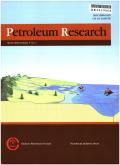油气储层压裂-膨化-渗流-膨化(FHnPP)过程性能评价
IF 4
Q1 Earth and Planetary Sciences
引用次数: 0
摘要
由于在小断块油藏高效开发方面的优异性能,压裂—膨化—渗流膨化技术近年来受到越来越多的关注。为了清楚地识别和理解相关机制,进行了油藏模拟,以评估油气藏中FHnPP过程的性能。设计了一系列基于单因素和正交方案的模拟场景来评估和识别主导因素。FHnPP的性能可以理解为:在注水过程中,形成的(微)裂缝从周围的水层延伸到地层深处,这一过程重建了压力场,使得在这些(微)裂缝关闭或部分关闭后,更多的被困油随后被驱回井中。表面活性剂可以有效降低水/油界面张力(IFT),但只会在早期增加产油量。次生裂缝的存在在早期对采收率有一定的提高作用,此后这种积极影响逐渐消失。基质渗透率越高,最终采收率越高,但压裂产生的积极效果随后就会降低。此外,裂缝在生产过程中的剩余渗透率(即膨胀过程)对采收率不利,而裂缝长度越长,采出油越多。注入速度和浸泡时间对采收率均有显著的正向影响,但后者的影响不显著。正交分析表明,影响采收率的主导因素的敏感性各不相同,而FHnPP优势对这些因素的敏感性也不相等。在优化后的FHnPP参数下,与传统的吞吐(THnP)工艺相比,目标储层的产油量显著增加,采收率(RF)达到3.59%(即609.1 m3)。本文的数值研究不仅证明了FHnPP技术的可行性和优越性,而且加深了我们对FHnPP技术性能的认识,确定了影响FHnPP技术性能的主要因素。本文章由计算机程序翻译,如有差异,请以英文原文为准。
Performance evaluation of fracturing-huff-n-percolation-puff (FHnPP) processes in a hydrocarbon reservoir
Due to its superior performance on the efficient exploitation of a small fault-block reservoir, a novel technique of fracturing-huff-n-percolation-puff (FHnPP) has received increasing attentions in recent years. In order to clearly identify and understand the associated mechanisms, reservoir simulations have been conducted to evaluate performance of an FHnPP process in a hydrocarbon reservoir. A series of simulation scenarios are designed to evaluate and identify dominant factors based on both single-factor and orthogonal schemes. The FHnPP performance can be understood as follows, i.e., created (micro-)fractures are extended from the surrounding water-zone deeper into formation during water injection, this process rebuilds the pressure field, enabling more trapped oil to be subsequently driven backwards the well after such (micro-)fractures are closed or partially-closed. Surfactants effectively reduce the water/oil interfacial tension (IFT), but it only increases oil production at early times. The existence of secondary fractures slightly enhances oil recovery at early puff-period after which such a positive impact is gradually vanished. A higher matrix permeability yields a higher ultimate oil recovery, but such a yielded positive effect from fracturing is then degraded. Moreover, the residual permeability of fractures during production (i.e., the puff process) negatively affect oil recovery, while a longer length of fracture results in more produced oil. Also, both injection rate and soaking time positively affect the oil recovery though the latter is insignificant. The orthogonal analysis indicates that, sensitivity of the dominant factors affecting oil recovery varies from each other, while the sensitivity of FHnPP's advantages to those factors is found also unequal. In the target reservoir with the optimized FHnPP parameters, significant oil increment (i.e., a recovery factor (RF) of 3.59% (i.e., 609.1 m3 oil)) can be achieved compared with that of the traditional huff-n-puff (THnP) process. This numerical study not only proves the feasibility and advantages of the FHnPP technique, but also deepens our understanding of its performance and identifies the dominating factors.
求助全文
通过发布文献求助,成功后即可免费获取论文全文。
去求助
来源期刊

Petroleum Research
Earth and Planetary Sciences-Geology
CiteScore
7.10
自引率
0.00%
发文量
90
审稿时长
35 weeks
 求助内容:
求助内容: 应助结果提醒方式:
应助结果提醒方式:


